Summer semester 2022: First EuroTeQ Collider at TUM
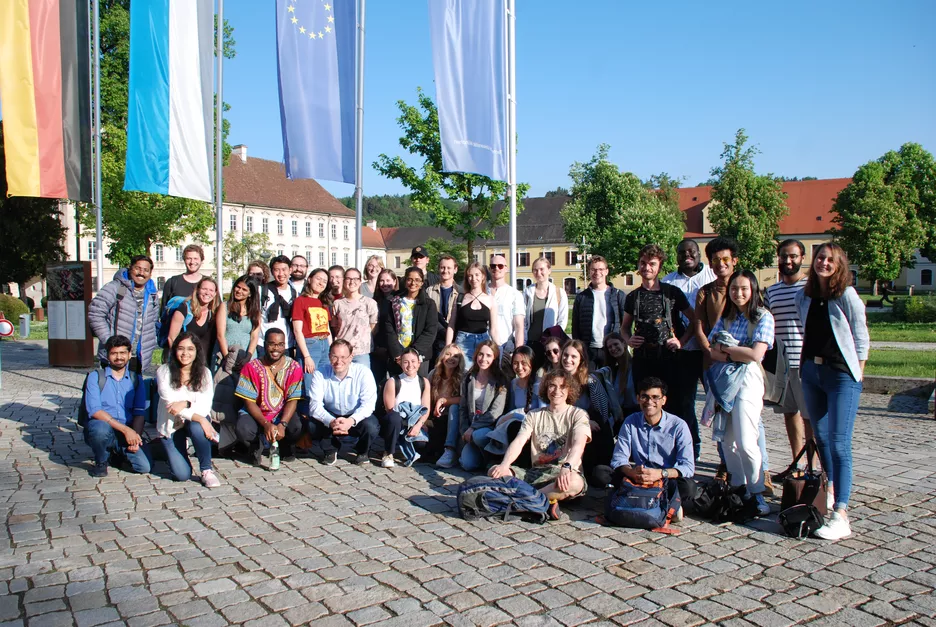
The first EuroTeQCollider 2022 was a great success.
In the summer semester of 2022, 12 highly motivated teams worked intensively with their mentors from business and research on solutions for their challenges under the motto "Leave no Waste behind". A total of 74 students from various bachelor's and master's programs took part in the project weeks.
At this point, we would also like to thank all challenge collaborators and mentors for their great commitment and support. Without them, the EuroTeQ Collider would have not been possible!
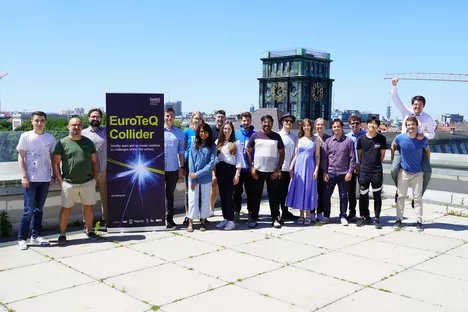
Winner teams of TUM and CTU at the EuroTeQaThon in Munich. Picture: Peter Finger/ TUM
EuroTeQaThon: June 10-12, 2022
After the local Collider project weeks at each of the six EuroTeQ universities, the best projects were presented at the EuroTeQaThon, from June 10 -12. The EuroTeQaThon was organized by the Junge Akademie and held in pairs:
- Tal Tech was hosted by DTU in Copenhagen,
- L'X met the participants at the TU/e in Eindhoven and
- CTU students from Prague came to TUM for the weekend.
The recording of all pitches during the EuroTeQaThon can be found here.
At TUM Collider level, the following teams in the three categories "Consumption", "Energy" and "City" were selected to present their projects at the EuroTeQaThon:
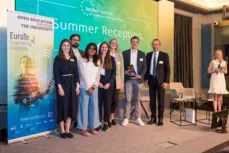
Challenge Collaborator and Mentor
Markus Forthaus, Siemens Advanta
What is the Waste Challenge?
Siemens Advanta challenged us to find a solution for medical imaging devices like MRIs and X-Rays that are currently unaccounted for to prevent an improper disposal. Wrongfully disposed medical imaging devices present a social and environmental threat as well as an economic loss for OEMs like Siemens Healthineers. We, Team Advan.ce, developed a sustainable and scalable solution consisting of three modules, namely a Device-as-a-Service strategy, a certified B2B-Partner network, and a Digital Platform, which alter the global linear business model of Siemens Healthineers to a circular one by closing the loops and hence prevents devices falling out of sight.
Pitch on the EroTeQaThon and qualification round at TUM
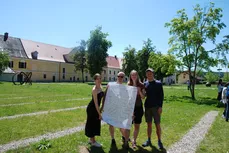
Challenge Collaborator and Mentor
Challenge-Collaborator: Plant a Seed | Mentor: Greg Jäger, Cyber Farms
What is the Waste Challenge?
Starting off as a subdivision of studen initiative Plant a Seed, we have develpoed an innovative vertical farm setup and came up with a strategy towards a more sustainable future. Our first step will be building our module on TUM Garching campus, where students will be able to learn more about urban farming and possibly even conduct their own research. From there, we would like to introduce our concept to larger urban communities and influence policy making to achieve food security, while rationally utilizing the resources.

Challenge Collaborator and Mentor:
Susanne Grohs von Reichenbach, Think Digital Green
What is the waste challenge?
The challenge focused on the topic of Digital Waste. Frankly, most of our team members were new to this concept. What was especially curious to us, as a team made up out of students interested in sustainable development who are fully immersed in the digital world, had little knowledge about the impact of digital waste. This showed us that more awareness on this topic was a worthwhile direction to discover.
We started with understanding the carbon footprint of our daily digital life and wanted to make a solution that would be simple and effective for creating more awareness about the issue and also develop a mobile application to help people figure out their digital footprint and give suggestions to reduce it. We also explored other issues of tge digital era and we hope the digital waste reduction and other targets for a new digital era would inspire creation of a new SDG 18.
Winners of the first EuroTeQ Collider 2022 at the European Level
We are delighted to announce that our TUM team Advan.ce was able to convince the jury members on the European Level. Their outstanding efforts and work make them the overall winners of the EuroTeQ Collider in the category Consumption.
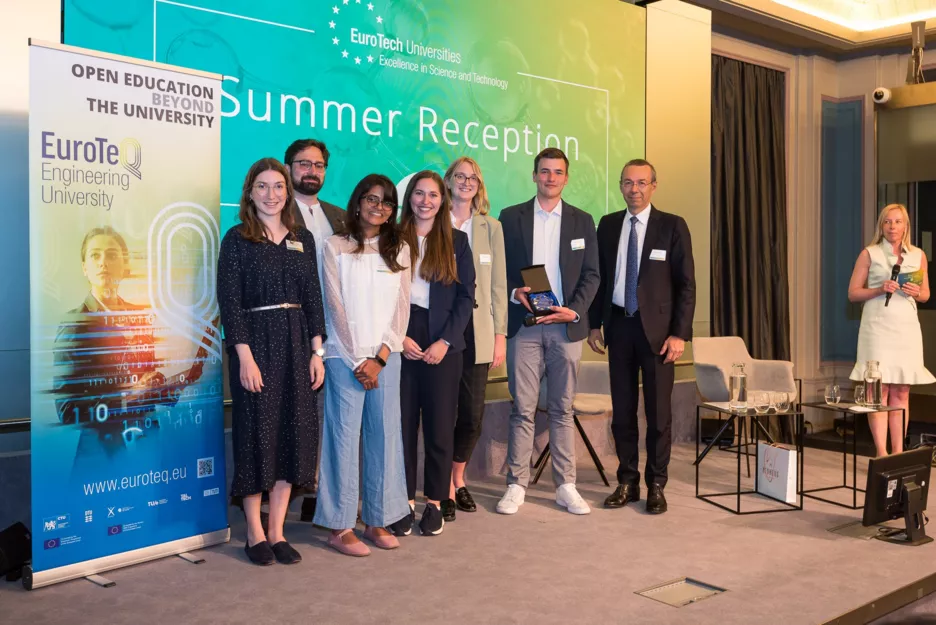
These were the challenges of the summer semester 2022
These were the challenges and mentors the participants could choose from.
How to get rivers and their ecosystems plastic and waste free? (Cities)
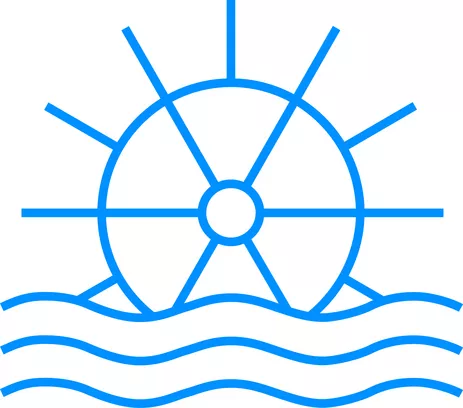

Introduction
Both humans and other animals are dependent on the availability of clean water. Rivers and oceans provide an important habitat for invertebrates, fish, birds and mammals. Humans strongly depend on intact river systems providing drinking water, irrigation for agriculture, transport routes and recreational areas.
Mismanaged Plastic waste is increasingly entering watercourses, either directly or via wind or surface transport during heavy rainfall harming marine and riverine ecosystems. Most of the plastic is transported via riverine systems to the ocean.
During the transport process, plastic accumulates in riverbanks, sediments, at water plants, in lakes and impoundments and remains within the riverine ecosystem for several decades. During floods, the retained plastic is remobilized and transported to the oceans.
Current cleaning technologies, as the RiverScreener, focus on preventing plastic emissions to the oceans via rivers, but neglect the long residence time of plastic in the river and its impact on the riverine ecosystems.
What is the Waste Challenge?
How to get our rivers and its connected ecosystems plastic and waste free?
As our rivers are polluted and the plastic remains for several decades in the river stretches, it is not enough to stop plastic input/ usage and to hinder plastic emissions to oceans. We have to clean our rivers as they are crucial elements for a healthy and intact environment.
-
Can we efficiently clean plastic polluted river beds and banks with technical solutions?
-
Can we find management strategies for rivers and impoundments that enables an easier cleaning technology?
-
Which biological factors need to be considered. Are fish or other species harmed by a developed method?
-
How can riparian and stakeholders participate? How can we create a social awareness of the problem?
Desired Outcome
Aim of this challenge is to restore our rivers all over the world. A fundamental step is the removal of the plastic by technical and management means. Those means should not interfere ecosystems and should provide a sustainable life cycle. The cleaning measure should sustain as long as possible, at the best for all future generations.
Desired Impact
2019 Unicef awarded the photo of the year representing the social situation of children in the slum Tondo in Manila in the Philippines. Former fishermen and kids swim through the polluted water in the bay fishing for plastic bottles, which can be sold to recyclers. This can be highly dangerous, especially during the typhoon season. Those people in the slum suffer from food poisoning, lack of drinking water, Dengue fever, diarrhea, Leptospirosis and skin diseases running rampant, malnutrition and in turn life expectancy is low. We want to improve the water quality and consequently life quality of humans. Simultaneously, we restore an intact riverine ecosystem providing habitats for fish, mammals, birds and invertebrates Fishermen should be able to fish for fish again instead for plastics.
Relevant considerations for the challenge/theme
As the already emitted plastic will remain for decades in the polluted river stretches, the problem is not solved by finding strategies to prevent mismanaged plastic waste input to the ecosystem. We also have to take care about the stored plastic waste in the rivers and have to find technical solutions in combination with management solutions to clean our riverine ecosystem.
We must not harm organisms of the ecosystem by our cleaning actions. Social participation can support acceptance for the measures by the riparian and stakeholders. At the end, we should improve the living conditions for the future generations!
Relevant links
https://www.un.org/pga/73/plastics/
https://www.cee.ed.tum.de/en/wb/projekte/riverscreener/
https://doi.org/10.3389/frwa.2021.786936
https://doi.org/10.3389/frwa.2021.724596
https://www.muhr.com/en/home.html
https://feature.undp.org/plastic-tidal-wave/#group-the-great-garbage-patch-KX7j6ucP2U
https://www.unicef.de/informieren/aktuelles/photo-of-the-year/contest-2019
The Ice Stupa Challenge - From the Himalayas to the Bavarian Alps (Cities)
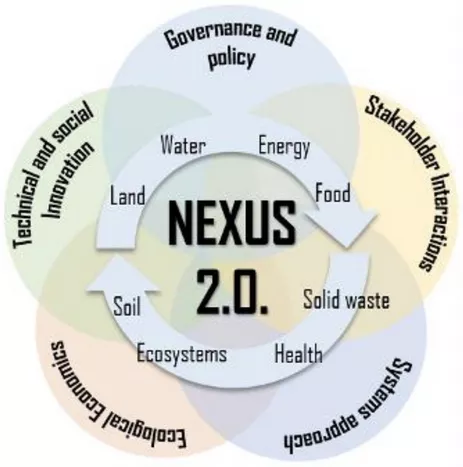
Introduction
With rising temperatures, glaciers around the world are melting at an alarming rate. For example, since 1850, glaciers in the Alps have lost between 30 and 40% of their surface area and half of their volume, with a further 10 to 20% of their volume having disappeared since 1980. At the current rate, glaciers within the Everest region are projected to lose about 40% of their ice by 2050, and around 83% by 2100.
In a context of progressive desertification and climate-related challenges, artificial glaciers have been built in the Himalayas for hundreds of years with the aim of freezing the water that otherwise flows downstream. This form of holding the water enables the community to have a water reservoir for domestic use and for the irrigation of their crops during springtime. In 2013, the Ice Stupa Project introduced an improved technique in the shape of vertical glaciers in Ladakh, built with a simple wooden structure and a pipeline. How could we upscale the Ice Stupa technique for it to effectively stop desertification and the melting of our natural glaciers?
Moreover, could we build our own Ice Stupa in the Bavarian Alps to use it as a Sustainable Living Lab to develop WEF Nexus-related applied and transdisciplinary research to save the glaciers and tackle climate change?
What is the Waste Challenge?
Building an Ice Stupa is an artisanal process that could be optimized through applied multidisciplinary research linked to the Water-Energy-Food Nexus. Leaving no waste behind in the context of this project implies making sure that the stupa water used for the households and crops is clean and treated before continuing its course downstream, where other species of flora and fauna can nourish from it. However, there are many other challenges associated to it. Namely:
- The need to import and transport pipes to highly inaccessible and protected mountain areas with no infrastructure (could we recycle PET bottles to craft our own pipes? Would such material be safe for water harvesting and resistant to such temperatures? What are other feasible solutions?)
- The energy to sprinkle the glacier should be only supplied by water pressure (the height difference and contraction choke are crucial)
- The control of the water melting and irrigating the crops require the design of outputs and a closed water cycle (also, water should be treated before going back to its natural stream or –even better- back to the glacier)
- The type of crops that can grow in such conditions is limited
- The need to conduct a feasibility study to determine the best location and needed resources to build our Ice Stupa (or a series of Ice Stupas) in the Bavarian Alps (could we bring Mr. Sonan Wangchuk – creator of the Ice Stupa Project in Ladakh – to mentor us? Could we try to contact Mr. Ovidiu Serghe, who managed to build one in Oberengadin/Graubünden in Switzerland to share their experiences and knowledge?)
- A plan to monitor and maintain the Ice Stupa(s) as a Sustainable Living Lab for it to generate data and knowledge that could be extrapolated to other places in the world
Desired Outcome
Wouldn’t it be great to do participatory action research while preventing glacier shrinkages? Bringing the Ice Stupa technology to the Alps as a Sustainable Living Lab will help us develop research to mitigate climate change impacts in our glaciers. We first need to study the feasibility of building Ice Stupas in the Alps (and therefore anywhere!), understand the conditions, implications, optimizing the building technology. Then, we will be able to verify how effective they are in protecting our glaciers and in irrigating our crops. If we manage to upscale this initiative, artificial glaciers could help us to stop the increase of ocean levels, desertification, and the imbalance of the food chain.
Desired Impact
The link of the Ice Stupa Challenge with the WEF Nexus implies the development of low-tech, nature-inspired, and high impact strategies towards water and food security in the region and beyond. This would also give us material to collaborate closely with the Ice Stupa Project in the Himalayas (together with their SECMOL School, a capacity building programme designed by them), and with the universities and research institutions that built an Ice Stupa in Switzerland.
Imagine all the data we could gather, all the (big and small!) strategies and systems we could test and optimize, all the changes in our glaciers we could monitor, all the water we could save, all the ecosystems we could protect by building this lab.
Relevant considerations for the challenge/theme:
As any early-stage project, there are financial and capacities issues. This means that we would need to make a feasibility study that would give us the information to generate a proposal to seek for funds. Moreover, once we have the funds we need to consider that building and maintaining an Ice Stupa in an inaccessible mountain region is not easy: there will be harsh weather conditions, lack of infrastructure, trial-and-error strategies, among others.
As this is a long-term challenge, the traced strategy could be divided into stages, for example: 1) Feasibility study + tracing a collaboration strategy, 2) Seek for funds, 3) Building the Ice Stupa (improving the construction technique?), 4) Monitoring and optimizing stage, 5) Building adjacent projects (e.g. raised beds and/or green houses for crops, prototypes of recycled pipelines, design of closed-cycle irrigation systems, etc.), 6) Data gathering and capacity building, 7) Upscaling the project (meaning more Ice Stupas in the Alps and beyond).
Relevant links
https://e-zeppelin.ro/en/mortalive-project-bringing-ice-stupas-from-the-himalayas-into-the-alps/
Recycling in developing countries - Mexico (Cities)

Introduction
In Mexico and in many other developing countries the waste management system is very informal and the culture and infrastructure for waste segregation and recycling is at its very first steps. At the best scenario, waste lands in legal landfills, but some portions of the urban waste are being illegally dump into rivers, illegal landfills or is burned at open sky. Just a small part of the peoples´ waste is recycled. In some cases, people can segregate their waste at home and then sell it to a collector center, which then sells it to recycling plants. The prices of the different materials, e.g PET, cardboard, HPD plastics, metals, etc, are dictated by the market for recycled materials. This system enables people with lower incomes to look in the waste bins and in landfills for those materials and sell them later to a collector center.
PIAS: Plantas de Impacto Ambiental y Social (Social and Environmental Impact Plants) is a project in Texcoco, Mexico that aims to create a facility for the revalorization of the waste. This revalorization center has a collection center for different types of waste materials and a recycling plant for multilayer packaging that works with solar energy and turns the multilayer packaging into cardboard and plastic pallets. PIAS want to make it possible for people to earn money from their waste, but more important, to give them the opportunity to invest the waste in the recycling facility and get benefits from the overall profits. In this way the people are using waste as a way of investment.
What is the Waste Challenge?
In this challenge we are going to explore the waste collection situation in smaller cities in developing countries, with the example of Texcoco, Mexico, with a strong focus on the following questions and on how the answers can help to develop the project.
- How do collectors’ centers work?
- How do they receive the waste and how they prepare it for the different recycling processes?
- How are the people being rewarded?
- Which rewards work better?
- How to get more people to segregate their waste?
- How to increase the amounts of materials that go to recycling?
- Are there ways to make the process more efficient without having a negative impact on the local people?
- How to involve technology /digitalization in this process?
- And how to guarantee a fair access to poorer sectors of the population?
- How can communities get more environmental and social benefits out of this part of the waste and recycling system?
- How can the waste investments of the people be monitored?
- How to involve existing systems?
- Note: please make sure that the challenge is open-ended
Desired Outcome
As a result, we want to have clear and structured strategies to implement at a small and big scale. We aim to increase communities’ participation in waste segregation, increase the amount of materials that are recycled and generate a positive impact on the environment and the communities around the collector centers and the recycling facilities.
A further goal is to make an MVPs to test the different ideas and alternatives that could improve the systems.
Desired Impact
As a desired impact we want to have more members of small communities that benefit from their waste segregation. We want them to understand the financial, social, and environmental benefits that they can create with every piece of trash that does not end in the landfill. This without affecting the workers on the waste sector.
Relevant considerations for the challenge/theme:
- Implementation is planned to be in Mexico
- We are focusing on the first part of the recycling process: recollection of waste, segregation of materials and conditioning for recycling.
- We want to have a strong focus on the social component: How to communicate with the locals and how to motivate them to be part of our project?
Relevant links:
Key stake holders: Ecolanacontacto(at)ecolana.com.mx
Building a Smart Irrigation System (Cities)

Introduction
Smart irrigation systems employ automation to save time and may use sensors to better decide when crops should be watered. Existing automated irrigation systems have shown to increase crop yield and reduce water use and labour. Industrial greenhouses have used such systems for a long time, but a transition to community gardening would be the next important step to give local communities more self-reliability.
What is the Waste Challenge?
The most important resource to consider with gardening is water. The main goal should be to quantify water usage and try to minimize it or even recycle it (e.g. using rainwater, or even grey water from household pipes). There are different types of irrigation, such as hand watering, drip- and subsurface irrigation, which may influence water use. Moreover, the structure of the gardening environment, be it raised beds or vertical farms, will also determine water use.
Using electronic components to regulate water flow will determine energy needs (e.g. using a timer versus a microcontroller running a Machine-learning algorithm to decide when to water plants). The electrical energy required to power the system should come from renewable sources if possible and must be minimized. The lifetime of components, such microcontrollers, and sensors, should be taken into consideration.
Key challenges to focus on:
- Saving water
- Recycling water
- Minimizing electricity use
- Avoid toxic battery usage
- Avoid electronic waste
- Avoid use of plastics, especially those which contain harmful additives
- Using renewable energy to power components (e.g. the pump, valve, microcontrollers, etc)
- Avoid too many electrical components (keep it simple)
- Focus on small-scale urban gardening, i.e. a simplified supply chain (e.g. no packaging, fewer trips to retailer)
Desired Outcome
A smart irrigation system which is easy to maintain and repair. As few electrical components as possible should be used to bring the system to life, with minimal battery usage, and certainly no chance of any toxic materials getting into the water. It should use water resources in a sustainable way and be reliable enough to grow crops that would otherwise be bought at a retailer, where transportation emissions become an issue.
Most importantly, the final system should be easy to work with, and help educate others about its purpose. It should show other members of community gardens the increased efficiency of automated watering.
Desired Impact
Community gardens are an important way of bringing people together in cities and creating a greener urban landscape. Automated irrigation systems will be an important way to reduce labour and time spent on watering. This will increase food security and create closer ties within a community and its environment. When the system is no longer needed, it should be disposable without leaving behind toxic waste.
Relevant considerations for the challenge/theme
Tips:
- Different plants have different water needs
- The plant uptake of water from the soil differs from crop to crop
- Considering what kind of vegetables are most attractive for community gardens
Out of Scope:
- Vegetable production supply chain
- Over-measuring things
Relevant links
https://cropwatch.unl.edu/2019/gap-growing-between-irrigated-rainfed-crop-yields
https://home.howstuffworks.com/recycle-water-for-outdoor-garden.htm
https://deepgreenpermaculture.com/2016/04/03/wicking-bed-construction-2/
https://scholarsjunction.msstate.edu/td/5207/
https://www.shawnee.k-state.edu/lawn-garden/Drip%20Irrigation%20for%20Community%20Gardens.pdf
How to utilize unused urban areas for food production? (Cities)

Introduction
Nearly 50% of the world’s population live in urban areas. Most of our food is sourced from outside urban areas and long transport chains are needed to bring that food to city centers. More than 1/3 of this food produced in traditional agriculture ends up going to waste. With current trends in population growth, soil degradation, and climate change effects, traditional agriculture won’t be able to keep up with demand. In contrast, vertical farming has 60% smaller CO2 footprint than traditional farming production, with minimal waste of goods. In addition, various forms of hydroponics have already proven to use at least 90% less water. By introducing food production into the city, transportation costs and related C02 emissions are reduced. This by no means suggests that current vertical farming methods can completely substitute traditional agriculture. For example, high energy consumption remains an obstacle, but it provides a much-needed additional source of food production.
What is the Waste Challenge?
Expanding on efficient hydroponic methods that can be employed in an urban environment, how can we bring an additional food production source closer to the consumer while keeping energy consumption, C02 footprint and food waste to a minimum?
Desired Outcome
By shortening the distance between farm to table, people will have an increased awareness of our food supply systems. Further implementation of vertical farming in our cities diversifies our food supply system and reduces fossil fuel usage from logistics and transport. Overall reduction in food waste due to local availability.
Desired Impact
With the addition of productive greenspaces in the city, people will be more connected to their food sources, value the crop more, and have a better understanding of its complexity.
Relevant considerations for the challenge/theme
Must include Indoor or outdoor hydroponics/vertical farming methods than can be applied to a variety of urban environments.
Relevant links
https://umwelt.asta.tum.de/rfu/language/en/projects/plant-a-seed/
https://www.cyberfarms.de/ https://www.thebalancesmb.com/what-you-should-know-about-vertical-farming-4144786
Blogs, reports and design software for Controlled Environment Agriculture
https://www.agritecture.com/blog/2021/11/16/plant-chicago-the-circular-economy-and-supporting-the-next-generation- of-entrepreneurs
International association for vertical farming in Munich
German NGO aiding with their farm food challenge
Social Innovation towards a sustainable European food system (Consumption)
Introduction
The European standard in the food system is highly unsustainable (highly processed and animal-based) and consumers are disconnected from food, its production and impact. So there is a call for societal awareness and engagement with the food system by the EU who fosters the farm to fork strategy. A shift to low-processed plant-based diets is needed. The foodprint approach is oriented at this strategy. It is a bottom-up social innovation towards a more sustainable diet. Food waste is an inconsiderate and inefficient use of resources (e.g., diets largely based on unsustainable foods) and careless consumption of food, without awareness of its value.
Food is not rational: Top-down, market based approaches perform poorly (ex: meat-tax). Most food information we are exposed to is advertisement. People are relegated to the role of consumers, have no say in shaping the food system. So finding innovative solutions to empower people to understand, reflect on and shape their Foodprint could be helpful.
What is the Waste-Challenge?
Develop a scalable and flexible package of initiatives, tools and interventions to implement to foster food education and awareness among Munich university students.
Proposal: Design an “Empowering Mensa”
- QR-code installations in strategic points (e.g. waiting line)
- app linked to a calculator to track the own Foodprint (including positive reinforcement mechanisms)
- sustainability scores for foods served and displayed along with nutritional information
Desired Outcome
Foster bottom-up social innovation towards more sustainable diets by increasing food awareness among European youth and foster food education in new, creative and unconventional ways.
- Students make more informed and sustainable food choices
- The concept could be extended to other EU universities and public institutions
- Increased societal engagement with the food system
- Food citizens define where they want their foodsteps to lead
Desired Impact
A world where people are connected to the food they eat, the way it is produced and the impact it has on the environment and on others. A world where people are not mere consumers, but food citizens contributing to shape a fair, democratic and sustainable food system.
Relevant considerations for the challenge/ theme:
- Highly interdisciplinary character: from developing technical tools (e.g., Foodprint calculator) to design and societal analysis
- Highly open-ended: creativity, flexibility, open-mindness, critical thinking, problem-solving attitude, respect, empathy
- Attitude & Communication: non-judgemental, positive and empowering
- Focus on gain framing, avoiding the rethoric of restriction
- Creative ways of educating and informing
- Explore synergies with stakeholders
Foodprint is not an organisation yet. But.. It could be soon! The team working on the challenge could outlive the EuroTeQ Collider. An integration within Plant a Seed is possible.
Relevant links
Student platform to reduce waste at TUM (Consumption)

Introduction
According to the United Nations Environment Programme we produce more than 11 billion tons of waste every year and in your private student life but also in the university context you contribute to this number. We would like to inspire you to find solutions around the topic of waste reduction for a by you selected area of the TUM campus waste and/or the waste TUM students generate in general. You as students with approx. 170 study programs at the Technical University of Munich can help us with your interdisciplinary know-how to tackle this challenge and to use the opportunities, which are provided by the internet, technology, and platforms.
What is the Waste-Challenge?
- How can a platform help to reduce waste at TUM?
- How should the platform be structured?
- What offers your platform and what waste problem does it tackle?
- What kind of items do you want to include?
- What data do you need and how are you going to work with it?
- How can cutting edge technology (AI, IoT, Mixed/Virtual Reality) help to simplify the usability and impact of the platform?
- What are the limitations of the platform?
- What are good incentives for using the platform?
- How should the platform be promoted?
- How can the success of the platform be measured?
Desired Outcome
Please develop a platform by students for students. We do not expect a finished/functional platform, but a prototype.
Desired Impact
The aim of the platform is to raise awareness for waste prevention. Inspire students to get active against unnecessary consumption and against impulsive consumption and a waste ignorance society. Show and communicate the clear commitment und path of TUM towards of a measurable waste reduction.
Relevant considerations for the challenge/ theme:
Think about what would help you to reduce waste and about the power of data, since we can’t solve a problem that we don’t fully understand.
Contact: t-ssalfetter(at)microsoft.com
Relevant links
Leave no waste behind in construction industry (Consumption)

Introduction
What has to be done for minimizing waste and optimizing reuse and recycling – data gathering and measurement, visualization and modeling to get the value chain transparent, the waste management predictive and optimized sorted towards a highly automated waste management plan per building/city.
Responsible management of waste is an essential aspect of sustainable building. In this context, managing waste means eliminating waste where possible, minimizing waste where feasible, and efficient reusing materials towards new high value material. Solid waste management practices have identified the reduction, recycling, and reuse of wastes as essential for sustainable management of resources. Therefore, the Construction Waste Management Plan should increase transparence of used materials, recycling rate of materials and optimized ways for demolition to create highly valuable resource based on waste recycling.
What is the Waste Challenge?
Due to increasing landfills, reduced accesses for new material resources (get supply chains reliable) and CO2-emission reduction the waste from construction, refurbishment and demolition has to improve the sorted recycling and reuse processes. Therefore, processes and products need to be transparent from begin (design) towards the end of buildings e.g., knowledge of materials and composites, recycling rate of product. New waste management processes are required to be visualized, modeled, and simulated for an optimized prediction and sorting of recycling and reuse of the materials.
1. Which methods and processes already exists for waste management to increase recycling and reuse of materials? Challenges and pains?
2. Which parameters/functions within the whole building-life-cycle have to be measured, transparent and predictive to install an optimized waste management process/steps? Improvements for clear recycling and efficient sorting?
3. Which processes should be modeled and simulated to optimize the recycling and reuse rate of buildings (construction, refurbishment, and demolition)
Desired Outcome
Recommendation of an improved waste management plan. Model/simulation for an optimized sorted waste management plan with interface to building-life-cycle models.
Desired Impact
Make building green based on energy efficient and waste handling. Highly rate of recycling and optimized reuse based on an improved sorted waste management, recycling certification per building, support of resilient supply chains
Relevant considerations for the challenge/theme:
Check today’s waste management due to challenges/pains/ room for improvements. Check easy-to-use modeling and simulation tools for waste management plans
Relevant links
A day in the life of a sustainability-minded engineer (Consumption)

Introduction
In most companies that develop, produce and sell products, business targets, portfolio strategies, processes and the organizational setup are still based on business paradigms that do not yet fully include sustainability. If industry takes on the challenge to avoid waste from production and later usage of sold products, use less water and energy during production, reuse materials and products at end-of-life, or avoid using critical materials in the first place, the effects of any improvements being implemented will not reach the full potential unless companies adopt a sustainability mindset in everything they do.
However, the required large-scale transformation of companies in the process of becoming truly sustainable is often unclear. What has become clear, though, is the widely accepted finding that companies determine up to 80% of products’ environmental impacts already at the product design phase (see link below). Therefore, starting the transformation towards true sustainability must as well include new approaches how to do product design.
What is the Waste Challenge?
Improving a product’s impact on the environment forces companies to change the way how the product is designed. Decisions on product architecture or used materials determine how effectively and at what cost the product can later be either recycled or brought back into reuse. Hence, product design is a huge lever to avoid/reduce waste, decrease CO2 footprint and water consumption during production, etc.
However, reducing waste by the design of a product is a complex task. Already in the very first step of product requirements specification sustainability requirements compete with customer requirements and those from inside the company – both technical and commercial. The interdisciplinary design teams will need to deal with this conflict of interest and find balanced compromises. At later steps, when defining the technical product specification team members will need to understand the life cycle effects of product design decisions on supply chains, manufacturing processes, service processes, and recycling technologies. Development engineers and production engineers will have to adopt a strong sustainable-product lifecycle orientation and will probably see their roles and scope of work become more versatile.
Key questions:
- Which roles and functions along the value chain (sales/marketing, R&D, procurement, manufacturing, logistics, service) need to be involved when developing products that are sustainable-by-design?
- Which roadblocks does the current product development paradigm create for products to become more sustainable-by-design and effectively support a zero-waste target?
- Which roadblocks are of technical nature (e.g. systems engineering methodology, product technology, IT tools, knowledge on materials, etc.) and which rather stem from people trying to preserve their current mindset, empowerment and behavior?
- What are the consequences for the future set of skills and behavior of a Sustainability-minded development engineer?
Desired Outcome
All transformations need guidance towards an attractive future state explaining in a comprehensible way how people will act differently in the future to reach defined goals. For this EuroTeQ Waste Challenge participating teams are expected to come up with a blueprint / picture of the future which will illustrate the way of working in the early phase of developing sustainable products. The blueprint shall depict the differences compared to traditional working modes with a focus on engineers in product development and manufacturing engineering. The blueprint shall make the necessary changes in skills and behavior of the engineers and the interdisciplinary team in their daily routines transparent and comprehensible.
Desired Impact
The blueprint will serve as an easy-to-understand and comprehensive future state description from which companies can derive transformation targets, strategies and implementation plans. The blueprint should be explicit enough to act as a guidance for recruiting, professional education, leadership development, human resources, operations excellence / process governance and operations in their definition of effective action plans.
Relevant considerations for the challenge/theme
Although several roles and functions in a company are affected in a transformation towards sustainability this waste challenge focuses on those roles directly involved in product design, at minimum the roles responsible for the technical development specification of products.
Relevant links
Circular Economy Action Plan, European Commission, 2020
Contact Markus Forthaus:
Tracking and sustainable treatment of deactivated products (Consumption)

Introduction
Siemens sells products into global markets either directly to customers or via resellers and system integrators. In many cases Siemens has detailed information about the installed base of products over the entire product life cycle. Often products are remotely monitored via permanent digital connections, and, therefore, Siemens also gets the information when a product is taken out of service. In that situation Siemens offers the customers to take back the products to ensure an environmentally responsible disposal or return to Siemens factories for reuse of components or refurbishing of entire products.
What is the Waste Challenge?
Unfortunately, the share of Siemens’ installed base of products without any information about location, customer, and usage status is significant. Typically, those products were sold via one or multiple resellers that for different reasons did not reveal the customer’s identity to Siemens. In other cases, registered products were sold by the customers to other customers, and from then on Siemens lost sight of those products. For example, the Siemens Healthcare business estimates the share of those products without any such information to be approximately 30% of their sold products (e.g. Computer-Tomography Scanners, Magnet-Resonance Imaging Scanners, X-Ray machines, Ultrasound devices, laboratory diagnostics systems, etc.). The share is higher in underdeveloped countries/regions and lower in more industrialized countries/regions, and lowest in Europe.
Siemens strives to reduce waste to an absolute minimum. However, for the share of products without any location/customer/status information Siemens has no control over the kind of disposal once those products are taken out of service. In the worst-case scenario customers may dispose even complete products in landfills, rivers, etc.
Key questions:
- How can Siemens ensure that no products from the installed base are disposed as waste – without Siemens knowing about it?
- For the suggested solutions, how can effort and cost for customers and resellers be kept at a minimum to avoid competitive disadvantages for Siemens?
- What solutions could minimize cost for Siemens, considering costly and CO2-generating logistics for returning deactivated products to Germany especially from the more distant regions of the world?
Desired Outcome
The suggested solution should enable Siemens to (again) get the current location/customer/status information of a product latest at the time of its deactivation/planned disposal. Based on this information Siemens can then decide on the optimal measures for reuse and/or recycling, and update its records for the monitoring of Siemens’ sustainability improvements.
Desired Impact
Siemens is responsible for the sustainable use and disposal of its products over the entire life cycle. The solution will significantly impact Siemens’ ability to avoid waste generation from Siemens’ products due to beyond-own-control disposal to landfill.
Relevant considerations for the challenge/theme:
Considered scope of products: Medical Imaging, Laboratory Diagnostics, Point-of-care Diagnostics
Relevant links
https://www.siemens-healthineers.com/de
Contact: Markus Forthaus
Internet: www.siemens-advanta.com/consulting
LinkedIn: https://www.linkedin.com/company/siemens-advanta-consulting
A pathway to e-waste management (Energy)
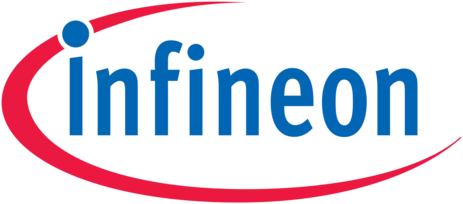
Introduction
Semiconductors have been an essential part of the information revolution which reshaped our society. Modern society would not exist without this vital resource. Moreover, semiconductors are fundamental to many sustainability solutions such as automation, smart infrastructure, electrification, and virtualization. One of the consequences of this tremendous growth is the constant generation of e-waste (electronic waste). E-wastes are various forms of electric and electronic equipment that have ceased to be of value to their users or no longer satisfy their original purpose. E-waste products have exhausted their utility value through either redundancy, replacement, or breakage and include both “white goods” such as refrigerators, washing machines, and microwaves and “brown goods” such as televisions, radios, computers, and cell phones. Given that the information and technology revolution has exponentially increased the use of new electronic equipment, it has also produced growing volumes of obsolete products; e-waste is one of the fastest-growing waste streams. Although e-waste contains complex combinations of highly toxic substances that pose a danger to health and the environment, many of the products also contain recoverable precious materials, making it a different kind of waste compared with traditional municipal waste.
What is the Waste Challenge?
Currently, the world produces up to 50 million tons of e-waste a year and, according to a report from the Platform for Accelerating the Circular Economy (PACE) and the UN E-Waste Coalition, that number is expected to reach 120 million tons per year by 2050 if current trends continue. In 2017, more than 44 million tons of electronic and electrical waste was produced—that’s more than thirteen pounds for every person living on our planet. The annual value of global e-waste is estimated at over $62.5 billion, greater than the GDP of over 123 countries. With e-waste as the fastest-growing waste stream in the world, the UN has called this issue a “tsunami of e-waste.”
Key questions
- How are e-wastes managed at the moment? (e.g. current status + market research)
- How can the e-wastes be reused or recycled efficiently with technologies using semiconductors? (e.g. AI, IoT, Deep Learning, Quantum computing, Big data, Pressure sensor, CO2 sensor)
- What are the strengths, weaknesses, opportunities, and threats of the e-waste management system you suggested and how can the risks be managed?
- What are the environmental, social (e.g. health, quality of life, food chain), and governmental implications of your e-waste management?
Desired Outcome
An e-waste management system is developed with a depth of understanding of current market status, technologies, and potential risks. It would make the devices containing semiconductors sustainable by recycling and materials reclamation.
Desired Impact
The impact of the desired outcome could be explained in correlation to the UN Sustainable Development Goals (SDGs). Solving the e-waste challenge could bring our society one step closer to following goals.
-
GOAL 3: GOOD HEALTH AND WELL-BEING
Ensuring healthy lives and promoting the well-being for all at all ages is essential to sustainable development. -
GOAL 6: CLEAN WATER AND SANITATION
Clean, accessible water for all is an essential part of the world we want to live in. -
GOAL 8: DECENT WORK AND ECONOMIC GROWTH
Sustainable economic growth will require societies to create the conditions that allow people to have quality jobs. -
GOAL 9: INDUSTRY, INNOVATION, AND INFRASTRUCTURE
Investments in infrastructure are crucial to achieving sustainable development. -
GOAL 11: SUSTAINABLE CITIES AND COMMUNITIES
There needs to be a future in which cities provide opportunities for all, with access to basic services, energy, housing, transportation and more. -
GOAL 12: RESPONSIBLE CONSUMPTION AND PRODUCTION Responsible Production and Consumption
-
GOAL 14: LIFE BELOW WATER
Careful management of this essential global resource is a key feature of a sustainable future.
Relevant considerations for the challenge/ the theme
In this challenge, technologies mainly refer to semiconductor embedded electronics such as AI, IoT, deep learning, quantum computing, big data, pressure sensor, CO2 sensor. For instance, inspiration can be found from the research of Piotr Nowakowski.
- An evolutionary approach to the vehicle route planning in e-waste mobile collection on demand (2021)
- Combining an artificial intelligence algorithm and a novel vehicle for sustainable e-waste collection (2020)
- Application of deep learning object classifier to improve e-waste collection planning (2020)
- Reconfigurable Recycling Systems of E-waste (2020)
- A novel, cost efficient identification method for disassembly planning of waste electrical and electronic
- equipment (2018)
- A proposal to improve e-waste collection efficiency in urban mining: Container loading and vehicle routing
- problems–A case study of Poland (2017)
Relevant links
Stop unnecessary carbon emissions! (Energy)

Agenda 2030: Why do we need a new Sustainable Development Goal 18 that covers the ecological impact of avoiding digital waste when generating and consuming data?
Introduction
Digital services and devices are omni-present in professional an private. Did you know that every citizen in Germany emits approx. 1 t of greenhouse gas emissions/year for digital applications? Most of us would do not feel well informed about this part of our entire carbon footprint (appr. 12 t p.a.). Estimations reveal that a high percentage of the footprint is due to unwillingly and unconsciously transmitted data.
Why is this? The digital lifestyle is linked to a physical side of data (e.g. server, networks) and to devices (resources, production and transport of digital devices, see SDG 12).
To focus on digital waste turns out to become more and more important as the total amount of data will climb up even more rapidly in the next few years. Experts discuss how to take into account the footprint of data due to energy consumption and how to tackle it. Estimations reveal that a high percentage of the footprint is due to unwillingly and unconsciously transmitted data. Note this quote: “…dark data causes the same amount of carbon dioxide emissions annually as 80 countries combined, explains Eric Waltert, Regional Vice President DACH at Veritas Technologies.” https://www.cloudcomputing-insider.de/ueberfluessiger-datenmuell-vergroessert-den-co2-fussabdruck-a-926234/
What is the Waste-Challenge?
Driving digital lifestyle and transformation respecting sufficiency of data means avoiding digital waste and useless spent energy. This would contribute to reach the goal of carbon free organizations, communities and even countries faster without any disadvantage or economical set back. The effect of reducing digital carbon footprints this way are probably underestimated.
Key questions
- The amount of data consumption raises every year. Which steps could be taken to understand, reduce, avoid or even recyle data in daily professional and private life? Think e.g. of digital decluttering, digital clean-ups, using digital services with the mindset of reducing data transfer …
- Try to design a masterplan: Who must take action for SDG 18 and how? (e.g. civic community, CIOs, sustainability officers, employees in total, digital agenda of ministries, sustainability consultants/agencies, influencer … )
Desired Outcome
Draft of a practical framework to give support to all individuals and organizations who handle data. Draft of communication toolbox that comes along with inspiring people to quit wasting data and causing useless carbon emissions.
Desired Impact
Every person who has been in touch with the framework and its easy and inviting practical tipps will “grow” for a new digital mindset: the sustainable way of enjoying digital life that strives for mindful handling of data without missing anything.
Relevant considerations for the challenge/ theme
- Analyze the approach “SDG 18” by Amy Luers in it’s full range. Then highlight references to digital waste.
- Data management: collection of relevant digital actions in daily private and business life (a daily schedule from waking up until going to bed at night could help to visualize individual digital activities)
- Estimation of the carbon footprint of data transfer and on the total footprint of citizens can serve as a motivating kick-off (data = energy = CO2)
- If the journey that data take is more visible, one could find approaches to avoid data, “cut” them off or identify data as waste and therefore neglectable. Think e.g. of folders of your E-mail-provider, video conferences, data storage of doc. Mp4, ppt etc.
- After depicting the big picture: Which guiding ideas could be helpful to avoid digital waste? For individuals and for an organization?
- If you were to explain to your friend what you have elaborated in this challenge: How would you do this? Work out a 3 min oral speech that will make him start at once fighting against digital waste
- (optional: Write an open letter to EU Commissioner Mariya Gabriel, suggesting that SDG 18 must ensure that the digital age respects digital carbon footprint at all levels)
- As a practical outcome of your study: a) Take part in a survey of futureearth.org and present your insights in plenary.“Tell us your thougths: What should an SDG on the digital age include?”
- https://futureearth.org/2020/07/02/the-missing-sdg-ensuring-the-digital-age-supports-people-and-planet/#survey b) check the sustainablewebmanifesto.com and it’s keys for a sustainable future and sign if you aggree https://www.sustainablewebmanifesto.com/
Relevant links
zip.Digital made it to the next round!
The Missing SDG: Ensure the Digital Age Supports People, Planet, Prsoperity & Peacegy Amy Luers
Rechenzentren von Dark Data befreienÜberflüssiger Datenmüll vergrößert den CO2-Fußabdruck(2020)
Digital Cleanup Day 2022/19/3 “what is digital trash” and further information/challenges
TUMA No-Waste Agribusiness in Zimbabwe (Energy)
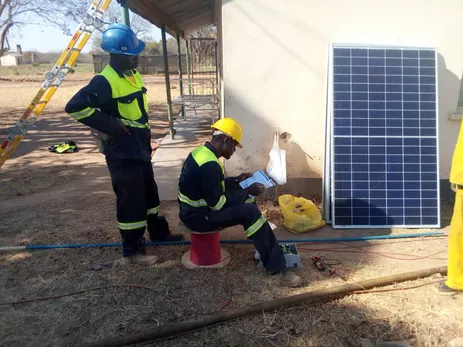
Introduction
In 2018, TU eMpower Africa (TUMA) launched its first Energy-Water-Food System in St. Rupert Mayer, a rural community 160 km away from Harare, Zimbabwe. The idea behind the project has been to provide people with reliable access to energy, safe drinking water as well as food security. As subsistence farming is the main food source in most rural areas in Africa, one of the objectives of the TUMA team is to make the system scalable, so it can be applied in other parts of Africa while keeping sustainability at the heart of their work.
In 2018, the first biogas plant was installed, producing up to 6 m3 of biogas per day used by the hospital's kitchen, avoiding the use of firewood. The hospital recently got completely solarized. Therefore, the resources of the biogas plant can be used in other use cases, such as the resulting systems of this challenge.
TUMA also installed 18 solarized panels to power a water pump, later relocated into another existing borehole. There has been a drafted agribusiness program to install drip irrigation systems further. The efficient use of available water for harvesting can ensure food supply to the community, as well as create employment for local people.
The system has been successful, resulting in the overproduction of certain crops (i.e., Tomatoes) in certain seasons. So far, part of the harvest is brought to the closest city markets to be sold. However, due to the absence of a suitable business solution for the utilization of overproduction, part of the crop is currently being wasted.
In a context where access to food is challenging, how could we integrate this surplus of produce into the agribusiness program? The strategy should make use of the already installed renewable energy systems.
What is the Waste Challenge?
Energy-Water-Food systems are fantastic approaches to food security challenges, especially in regions aggravated by the lack of access to water, unreliable energy supply, and poor infrastructures.
Can this approach make this project fully sustainable? Can we secure access to nutritious food for the community, provide a few steady jobs, and avoid the waste of natural resources?
The strategy is to build on the already installed renewable energy systems, with a EWF Nexus approach. Some challenges that could be turned into strategies are, for example:
- Making use of the solar-powered kitchen.
- Use the water supply to dry the food, get it canned, fermented/pickled, preserved in salt and sugar, cooked, etc.
- The design of a distribution system that does not rely on fossil fuels for transportation and/or focus on the local markets.
- Development of products from seasonal crops to create stable incomes for people of the community.
- Utilize organic waste generated all along the supply chain for renewable energy production in Biodigesters.
- Creation of Circular economy by utilization of organic fertilizers generated from the agro-business.
- Control and monitor the surplus to avoid wasting resources?
- As one of the objectives of the TUMA team is to make the system scalable, what if more local farmers could join the project?
Desired Outcome
A climate-smart agribusiness plan that could help the community in St. Rupert Mayer overcome the challenges of food insecurity, food waste and unemployment with climate-resilient practices.
Desired Impact
The link of the climate-smart agribusiness plan with the WEF Nexus entails the use of technologies that do not damage the environment. Furthermore, it will raise awareness among the community and the local farmers about different ways of producing and processing food. It could create a domino effect that would lead to capacity development and to scale the system within the local farmers.
Relevant considerations for the challenge/ theme
The establishment of the agribusiness plan requires time, effort, and resources. It also requires traveling to Zimbabwe and reaching St. Rupert Mayer after a long journey that feels like an odyssey due to poor infrastructures and weak public transportation connections.
Working directly with the community and discovering what are their strengths so we can build on them. It involves the need of having/developing certain soft skills (such as good communication, empathy, sensitivity) knowing that they are the ones that have much of the knowledge and that we bring the technology to fit their reality. Taking into account what the community is all about should never be underestimated, especially when taking a participatory approach.
Relevant links
Creating the universities of tomorrow by optimizing lectures with regards to their energy efficiency (Energy)

Introduction
The past two years have rocked the universities across the world with presence lectures no longer being possible and online lectures becoming daily routine. While many students are longing for a return to education in presence, the experience and know-how gathered over the past semesters about online teaching cannot be ignored. As the biggest difference between presence and online lecture, transport has a significant impact on the energy consumption of lectures. Through optimization of lecture schedules and a mix of online and on-site lectures, universities could potentially reduce their energy footprint. We already have developed a simple calculator tool, our elecCalc, which allows lecturers and students to calculate the energy consumption of individual lectures. Using this toolkit as a base, we want to expand on this idea and create a tool which is easy and convenient to use, but also sophisticated under the hood. Eventually, this calculator could then be routinely integrated in the planning and scheduling of lectures.
What is the Waste Challenge?
By challenging the participants to expand our elecCalc and create a tool that can be used to plan energy-efficient schedules, we are challenging them to understand and help others understand the impact of daily activities on our energy consumption. Through our challenge, all stakeholders can understand the impact of transportation on the energy consumption of lectures and acknowledge the opportunities given by digitalization. Having built this understanding and acknowledgment, both the challenge participants and the future users of the expanded elecCalc can efficiently shape their daily lives to avoid wasting energy, for instance through unnecessary commuting.
Key questions:
- How can the students' schedules be optimized with the help of known energy consumption of individual lectures?
- Can the energy consumption of lectures be minimized by creating hybrid lectures where the splitting is based on travel distance?
- What are key infrastructure components, through which the universities themselves can significantly save energy?
- What is the minimum amount of information such a calculator needs to produce sensible results?
- How can you create a tool that is suitable for different universities?
Desired Outcome
The desired outcome of this challenge is an improved (re-)implementation of our elecCalc toolkit, making it a more feature-rich and user-friendly experience. It should provide a toolkit for both students and lecturers to analyze the energy consumption of lectures, giving them the opportunity to optimize individual lectures as well as weekly schedules under the aspect of energy efficiency.
Desired Impact
Both lecturers and students alike have told us constantly that they would be very interested in knowing about the energy consumption of lectures, yet there is no tool available to easily gain access to this information. With our elecCalc, we intend to change this. While actively changing people’s behavior towards conserving energy might be a rather ambitious goal, raising awareness about issues is an important first step in this endeavor. By offering an easy-to-use, yet powerful toolkit, we intend to follow this initial step with the aim to change the way university lectures are planned and held towards a less energy-intensive scenario.
Relevant considerations for the challenge/theme
- The energy consumption of a lecture is very complex and influenced by several aspects. It is important to find a middle ground between a model simple enough so that the relevant data can be gathered easily and a model complex enough to not miss important details. You will need to make assumptions, but be careful to not oversimplify the model.
- Developing a calculator toolkit requires work on many fronts: The core calculator needs to be programmed with the appropriate model, taking care of as many edge-cases as possible. A pleasant and comfortable interface has to be created, such that the usage of the calculator is intuitive to use. Documentation has to be written. The list goes on. As a consequence, resources have to be allocated accordingly and you will need to make compromises to cover all tasks. What works for one university, might not work for another university. Make sure that the calculator is not designed to work only with one specific university in mind.
- The current elecCalc is published under a GPLv2 license, meaning that anyone can contribute to it. But this also means that, if you want to use it as a base, it must not result in a proprietary calculator tool. Also think about modularity and expandability so that, in the future, it is easy to add more functionality to it.
- The participants must agree with having the outcome of the challenge further expanded, for instance through other hackthons. Further, the participants must agree with making the outcome accessible to other TUM organizations, so that, in the best scenario, the final product can be adopted by a TUM organization and continuously used in favor of the whole TUM community and other universities.
Relevant links
Current publicly available version of the elecCalc toolkit
Scientific & technical implementation: Alexander Holas (alexander.holas(at)tum.de)
Data collection & communication: Catherine Yngaunis Koch (catherine.koch(at)tum.de)
Transforming ReUsed IT products to a status symbol (Consumption)

Introduction
E-waste is the fastest growing waste stream in the world. To slow the growth of the waste stream and enable its use in the circular economy, we can create a positive impact through our consumption. By extending the use and life of IT products, this is possible. So why not make the use of refurbished products a status symbol?
According to the Circularity Gap Report 2021, 70 percent of global greenhouse gas emissions are directly related to the extraction, transport, processing and use of materials.
What is the Waste-Challenge?
How can ReUsed IT products like Smartphones, Tablet or Laptops become visible as a state symbol / status product?
- How ReUsed IT can become a status symbol?
- Are there already trends that can be used to transform mindsets?
- Could there be labels or seals supporting the change?
Desired Outcome
Until now the opinion has prevailed that the newest and most current always emphasizes the status. What levers can be set to achieve a change in our society in a different direction regarding the consumption of IT products?
Desired Impact
Minimizing the fastest growing waste stream is a powerful opportunity in terms of resource conservation and climate protection. We all have it literally "in our hands every day" to make this change. As soon as it becomes clear that you have consciously chosen a resource-saving alternative and visibly display this to the outside world, you make a public statement for climate protection.
Relevant considerations for the challenge/ theme:
Today, there are already a few examples that show that trends can positively influence our consumer behavior. A new trend does not always have to be established. Perhaps things can be adapted or combined with each other.
Relevant Links
https://theclimatechoice.com/de/kreislaufwirtschaft-best-practice-it-remarketing/
How can the macroeconomic impact of a Hyperloop route be quantified and predicted for the connected regions? (Cities)
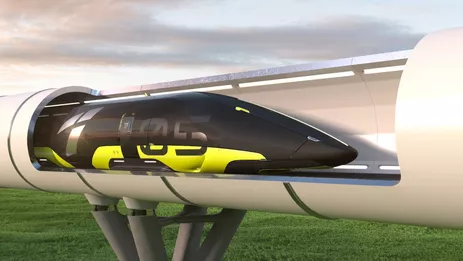
Introduction
In 2020, TUM Hyperloop launched a research program within TUM to build a 24-meter test track and full-scale prototype, marking the team's first step toward realizing Hyperloop on a large scale. As Hyperloop moves toward realization, the success of the project depends not only on technological implementation, but also on stakeholders recognizing the value and positive impact of the transportation mode on social, regional and economic development.
What is the Waste Challenge?
The ever-increasing demand for mobility requires governments across Europe to continuously invest in infrastructure, connecting regions and improving access to transportation. The Hyperloop, which enables extremely high speeds on the ground (approximately 850 km/h), allows long distances to be covered in minutes instead of hours, revolutionizing overall travel times (e.g., Munich to Frankfurt in 30 minutes instead of 3 hours). To convince governments, investors, and the public of the system's benefits, TUM Hyperloop is seeking a scalable approach and initial results that convey and quantify the economic and social benefits of implementing Hyperloop routes. Some key questions the team is trying to answer:
- Which macroeconomic dimensions would have to be analyzed on the basis of a chosen route (e.g. MUC - FRA, MUC - BER)?
- How can the social, regional and economic impacts be quantified and which are the most important ones?
- What trends might result from this radical reduction in travel time, e.g., modal shift in passenger/freight traffic, reduction in pollution, etc.?
- How can these results be successfully communicated to stakeholders?
Desired Outcome
By developing a tool to predict economic and social impacts in regions connected by a Hyperloop, decisions to invest and deploy a Hyperloop on a given route can be informed by where the greatest benefits would accrue for all stakeholders.
Desired Impact
Governments and investors are able to deliver new transportation infrastructure in ways that go beyond simply moving people between places. It creates economic and social impacts that can be measured. When these benefits can be demonstrated, communication with decision makers and the public is results-oriented and increases the chances of successful Hyperloop implementation.
Relevant Considerations for the challenge/theme
Considering the complexity of the task, reasonable simplification assumptions should be made
Relevant links
Electrification of Aircraft (Energy)

Introduction
Energy used for transport is a significant percentage of each person’s energy utilization. For example, in the UK, it is estimated that on average 32% of a person’s energy consumption is used for transport Sustainable Energy – without the hot air - Current consumption.
Electrification of automotive vehicles is well underway, but there is still much to be done to electrify flight. The required energy density required for aircraft often comes from sources of combustion which are not sustainable or environmentally friendly. Electrification of aircraft provides opportunity for propulsion energy to come from clean and renewable green energy sources. To succeed it is essential that you provide clear, quantitative, data-driven conclusions underpinned by use of rigorous mathematical models and time-domain simulations.
What is the Waste Challenge?
You will use an existing MATLAB®, Simulink®, and Simscape™ representation of an all-electric aircraft as the basis for this project. You will extend this by building models of a variety of aircraft electrical energy storage and equipment which permit a thorough evaluation of energy consumption. Use the models to provide informed, data-driven, comparisons, and recommendations as to the most promising electrical configurations and technologies.
Suggested steps:
- Become familiar with existing electric aircraft models (links below) and use these as the basis for your project.
- Project variations: Choose one of the following project ideas:
- Build or integrate a model of an energy storage system. Consider weight, size, and efficiency of one of:
- Hydrogen
- Fuel Cell
- Battery
- Other novel sources?
- Use the model to compare advantages of different distribution systems:
- AC
- DC
- Mixed AC/DC
- Build or integrate a more detailed and representative model of one of these loads:
- Propulsion
- Sensors and electrical actuators
- HVAC
- Galley/Hotel
- Infotainment
- Other areas?
- Build or integrate a model of an energy storage system. Consider weight, size, and efficiency of one of:
- Calculate expected efficiency and power requirements for a variety of typical flights
- Write up data-drive recommendations to influence each of:
- Individuals – should technologies you investigated influence flight purchasing decisions by passengers?
- Industry – should the technology you investigated be further developed and why?
- Government – shape government policy to direct investment and multiply the benefits
Advanced project work:
- Pick additional item/items from the project variations above.
- Parameterize the aircraft for multiple configurations: a variety of passenger capacities and multiple geographic locations.
- For comparative purposes, build one model of conventional
- Propulsion, or
- Actuation
Desired Outcome
Show the feasibility of an aircraft energy system leading to lower emission rates, e.g., by optimized energy provision, energy distribution or energy conversion. This demo will be openly available on GitHub for the community to foster further evaluation for the enhancement of knowledge.
Desired Impact
Contribute to the global transition to zero-emission energy sources by electrification of flight.
Background: In 2018, aviation was estimated to be responsible for 2.5% of anthropogenic CO2 emissions, with projections predicting values of up to 5% in 2050. Other aviation emissions (e.g. water vapor, nitrogen oxide emissions, etc.) that contribute to climate change, attribute an even higher impact on climate change to aviation emissions (from 2020 white paper ZERO EMISSION AVIATION, p. 11).
Relevant considerations for the challenge/theme:
This project is to be developed using MathWorks’ tools and made openly available for the community. This will be in the form of demos, simulations and models.
Relevant links
The challenge can be found on Github (Electrification of Aircraft) as Part of MathWorks’ Excellence in Innovation Program.
Background Material:
